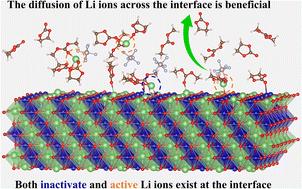当前位置:
X-MOL 学术
›
J. Mater. Chem. A
›
论文详情
Our official English website, www.x-mol.net, welcomes your
feedback! (Note: you will need to create a separate account there.)
Diffusion behaviors of lithium ions at the cathode/electrolyte interface from a global neural network potential
Journal of Materials Chemistry A ( IF 10.7 ) Pub Date : 2024-11-06 , DOI: 10.1039/d4ta05530f Yufeng Sun, Cheng Shang, Yi-Bin Fang, Zhi-Pan Liu, Xin-Gao Gong, Ji-Hui Yang
Journal of Materials Chemistry A ( IF 10.7 ) Pub Date : 2024-11-06 , DOI: 10.1039/d4ta05530f Yufeng Sun, Cheng Shang, Yi-Bin Fang, Zhi-Pan Liu, Xin-Gao Gong, Ji-Hui Yang

|
The diffusion of Li ions plays a vital role and has been the central topic of the Li-ion battery (LIB) research. However, the diffusion behaviors at the cathode/electrolyte interface still remain unclear due to the complexity of interfaces. Despite achieving some progress through ab initio molecular dynamics (AIMD) and classical molecular dynamics (MD) simulations, a full understanding of Li-ion diffusion behavior requires direct simulation of the entire interface. This remains challenging due to the inherent limitations of current simulation methods. Here, we develop a global neural network potential to reveal the Li ion diffusion behaviors at the interface between the LiCoO2 cathode and liquid electrolytes (EC, DMC and LiPF6) by performing long-term molecular dynamics simulations. We identify four kinds of interfacial diffusion behaviors by analyzing the trajectories of Li ions. While the inactive Li ions are immobile, the active Li ions can shuttle between the interface and solution regions, hop between different interfacial sites, or diffuse as they would in pure electrolytes. Among all diffusion behaviors, only the diffusion across the interface can contribute to the effective conductivity and thus the device performance. Based on the above findings, we further study the influence of electrolyte concentration and interfacial compounds on the diffusion of interfacial Li ions. We show that 1 mol L−1 LiPF6 has the largest conductivity across the interface, in agreement with the experimental results that 1 mol L−1 LiPF6 is the most suitable electrolyte concentration. We further propose that Li2O could be used as an interface coating to improve the Li ion conductivity across the interface. Our work provides deep atomic insights into the dynamics of Li ions at the cathode/electrolyte interface and is expected to help the optimization of LIBs.
中文翻译:

来自全局神经网络电位的锂离子在阴极/电解质界面的扩散行为
锂离子的扩散起着至关重要的作用,一直是锂离子电池 (LIB) 研究的中心主题。然而,由于界面的复杂性,阴极/电解质界面的扩散行为仍然不清楚。尽管通过从头计算分子动力学 (AIMD) 和经典分子动力学 (MD) 仿真取得了一些进展,但要全面了解锂离子扩散行为,需要直接仿真整个界面。由于当前仿真方法的固有局限性,这仍然具有挑战性。在这里,我们开发了一个全局神经网络潜力,通过进行长期的分子动力学模拟来揭示 LiCoO2 阴极和液体电解质(EC、DMC 和 LiPF6)之间界面处的锂离子扩散行为。我们通过分析锂离子的轨迹确定了四种界面扩散行为。当非活性锂离子不动时,活性锂离子可以在界面和溶液区域之间穿梭,在不同的界面位点之间跳跃,或像在纯电解质中一样扩散。在所有扩散行为中,只有跨界面的扩散会影响有效电导率,从而影响器件性能。基于上述发现,我们进一步研究了电解质浓度和界面化合物对界面锂离子扩散的影响。我们表明,1 mol L-1 LiPF6 在整个界面上具有最大的电导率,这与 1 mol L-1 LiPF6 是最合适的电解质浓度的实验结果一致。 我们进一步提出 Li2O 可以用作界面涂层,以提高界面上的锂离子电导率。我们的工作为阴极/电解质界面处的锂离子动力学提供了深入的原子见解,有望有助于优化 LIB。
更新日期:2024-11-06
中文翻译:

来自全局神经网络电位的锂离子在阴极/电解质界面的扩散行为
锂离子的扩散起着至关重要的作用,一直是锂离子电池 (LIB) 研究的中心主题。然而,由于界面的复杂性,阴极/电解质界面的扩散行为仍然不清楚。尽管通过从头计算分子动力学 (AIMD) 和经典分子动力学 (MD) 仿真取得了一些进展,但要全面了解锂离子扩散行为,需要直接仿真整个界面。由于当前仿真方法的固有局限性,这仍然具有挑战性。在这里,我们开发了一个全局神经网络潜力,通过进行长期的分子动力学模拟来揭示 LiCoO2 阴极和液体电解质(EC、DMC 和 LiPF6)之间界面处的锂离子扩散行为。我们通过分析锂离子的轨迹确定了四种界面扩散行为。当非活性锂离子不动时,活性锂离子可以在界面和溶液区域之间穿梭,在不同的界面位点之间跳跃,或像在纯电解质中一样扩散。在所有扩散行为中,只有跨界面的扩散会影响有效电导率,从而影响器件性能。基于上述发现,我们进一步研究了电解质浓度和界面化合物对界面锂离子扩散的影响。我们表明,1 mol L-1 LiPF6 在整个界面上具有最大的电导率,这与 1 mol L-1 LiPF6 是最合适的电解质浓度的实验结果一致。 我们进一步提出 Li2O 可以用作界面涂层,以提高界面上的锂离子电导率。我们的工作为阴极/电解质界面处的锂离子动力学提供了深入的原子见解,有望有助于优化 LIB。


















































 京公网安备 11010802027423号
京公网安备 11010802027423号